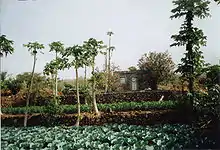Agriculture in Cape Verde
Agriculture in Cape Verde is an industry that has plenty of potential.
Crops

The most widespread agricultural activity of the Cape Verde islands is gardening for domestic consumption. Garden crops include corn, cassava, sweet potatoes, and bananas. Only about 11.2 percent of the land area is suitable for crop production. Frequent droughts often exacerbate an ongoing water shortage. Agriculture employed about 21% of the active population and contributed 15% to GDP in 2003. Estimated 2004 production figures were sugarcane, 14,000 tons; corn, 14,000 tons; bananas, 6,000 tons; coconuts, 5,000 tons; mangoes, 4,500 tons; cassava, 3,000 tons; and potatoes, 3,500 tons. Only the islands of São Tiago, São Vicente, São Nicolau, Fogo and Santo Antão have conditions suitable for raising cash crops. Bananas, almost the only agricultural export, are grown on irrigated land. On Fogo, wine and coffee are grown for export: In 2008, 108 t of grapes where harvested on an area of more than 200 ha.[1] In 2008, 21 t of coffee were harvested on Fogo after 35 t in 2006 and 45 t in 2007.[2] Sugarcane, another cash crop, is used on the islands to produce rum.
Development
Agriculture has been the focus of development aid programs since the 1960s, but progress has been frustrated by drought, locusts, overgrazing, and archaic cultivation methods. Approximately 85–90% of food needs are met by imports; agricultural imports had a value of $112.8 million in 2004.
Land reform
The African Party for the Independence of Guinea and Cape Verde (PAIGC) nationalized a few large-scale irrigated agricultural operations and began a program of land reform and cooperative agriculture; sharecropping was abolished. During 1976–80, 7,200 rainwater dikes were built. Torrential rains in 1984 destroyed much of this work, but by 1986, 17,000 dikes and 25,000 stone retaining walls had been completed. There has been little land redistribution, despite a 1982 law distributing farms over five hectares (12.5 acres)—1 hectare (2.5 acres) if irrigated—among the tenants if the land is not directly farmed by the owners.
References
- Pitt Reitmeier: Cabo Verde, p.394. Bielefeld 2009.
- Susanne Lipps: Kapverdische Inseln, p. 262. Ostfildern 2009
![]() This article incorporates public domain material from the Library of Congress Country Studies website http://lcweb2.loc.gov/frd/cs/.
This article incorporates public domain material from the Library of Congress Country Studies website http://lcweb2.loc.gov/frd/cs/.